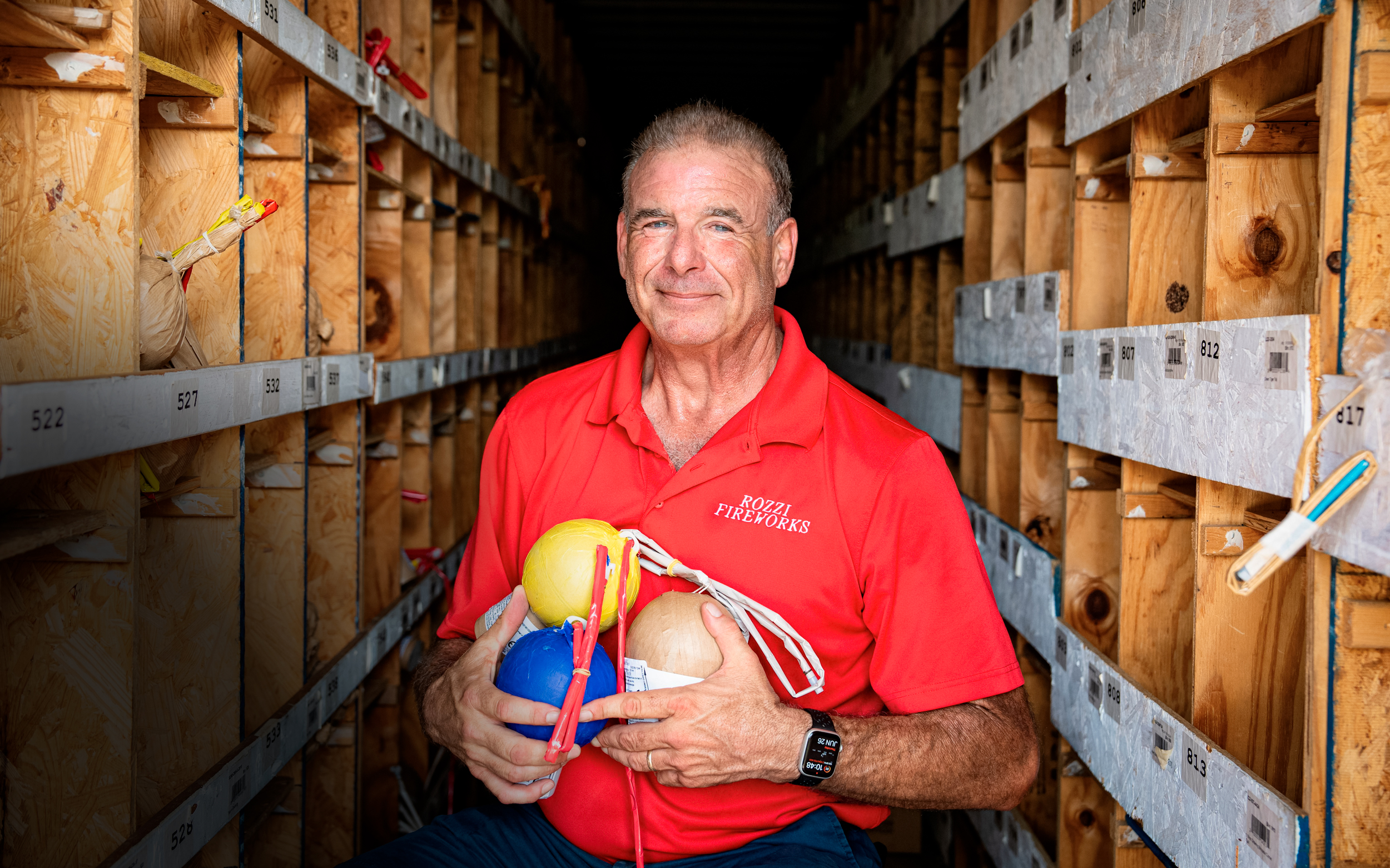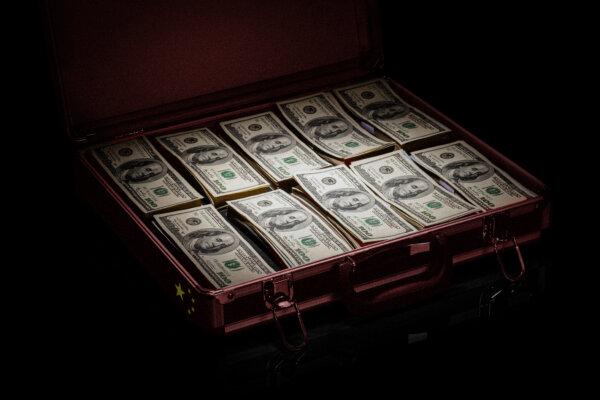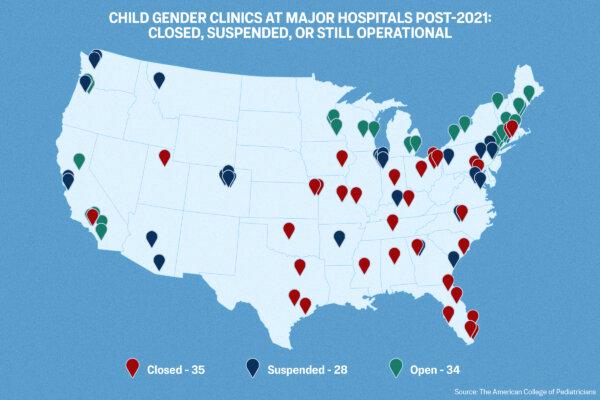MARTINSVILLE, Ohio—Along a Clinton County country road, adjacent to a winter wheat field, July 4 magic is in the making—all year long.
This nondescript 110-acre parcel is where the Rozzi’s Famous Fireworks crew incubates ideas and assembles its regional, national, and international shows—upholding a family legacy that originated in Italy more than a century ago.
While the company puts on close to 400 shows per year, almost 100 of them happen on and around Independence Day throughout the Midwest and the Eastern United States.
“It’s hard work, and everything rides on the Fourth of July,” said Joe Rozzi, the company’s vice president of sales and pyrotechnics designer. “When you guys are looking forward to having a barbecue on the Fourth of July, we’re working all year long for the Fourth of July; that’s what we do.”
Above all other holidays, the annual Independence Day celebration makes or breaks U.S. fireworks businesses, small and large alike, Rozzi and other industry leaders told The Epoch Times.
For Rozzi, it’s more than a business. It’s about stoking family pride, keeping traditions while modernizing, caring for those who work for the company, and entertaining spectators who delight in Rozzi’s spectacle in the sky.
“That’s what I like most about it: the people,” Rozzi said.
Even though the work is perilous and requires physical labor in all types of weather, “everybody who does this loves to do it,” Rozzi said.
With just 11 full-timers—including a fifth-generation Rozzi—the company relies heavily on part-time employees—300 of them.

Many part-timers return year after year and have become extended family to the Rozzis. They include bankers, lawyers, firefighters, an optician—and even a professional magician, James Finkelmeier.
“It is a form of magic,” Finkelmeier said, referring to when all the carefully orchestrated parts of a fireworks show come together.
A part-time Rozzi’s shooter for 20 years, Finkelmeier, 45, often makes a nearly four-hour drive from his Cleveland-area home so he can stage Cincinnati-area events.
How the Sparks Started
Pyrotechnics have mesmerized audiences for centuries and have symbolized patriotism since America’s earliest celebrations of nationhood.But increasing challenges confront the family-centered business model that defines the fireworks industry in the United States.
The nation’s fireworks industry was largely built by Italian American families such as the Rozzis, relying on their cultural heritage.
Joe Rozzi’s great-grandfather, Paolo Rozzi, began his fireworks business in Italy in 1895. After the patriarch emigrated to the United States in 1900, he set up shop in Pennsylvania.
Three decades afterward, some of his relatives relocated to the Cincinnati area. That’s where Rozzi’s Famous Fireworks and a second Rozzi company, Arthur Rozzi Pyrotechnics, continue operations.

“The Fourth of July has been special for my family, because that’s when we were always together,” Rozzi said. “We’re always working together.”
Several of his kin still lead the business. His sisters, president Nancy Rozzi and client liaison Kathy Rozzi, work at the family’s consumer-fireworks store in the Cincinnati suburb of Loveland.
Joe Rozzi’s nephew, Michael Lutz, left a Wall Street career. He now serves as vice president of finance and operations, soundtrack engineer, and pyrotechnic display designer, based at the Clinton County farm.
Industry Changes
Prior to the 1970s, each American fireworks company typically made and shot off its own fireworks products.But after the United States reopened trade with China, beginning in 1972, U.S. fireworks companies decided to try Chinese-made devices.
By the 1980s, American fireworks makers began buckling under the weight of Chinese competition and strict government regulations. Rozzi’s hung onto its manufacturing until 2010. Today, there are only a few “mom-and-pop” American fireworks makers left; none is big enough to supply major display companies such as Rozzi’s.
Rozzi misses making customized products.
“Our colors were better; our effects were better,” Rozzi said, and each item inspired confidence in users because “you knew who made it.”
The purity of chemicals can change the quality of colors displayed in the sky.
“No one in my family is a chemist,” Rozzi said, but the family has discovered that doesn’t matter. “Chemists could do all the equations—and on paper, it looks great. And then they try to make it, and it doesn’t work so well.”
On the other hand, a fireworks expert knows how to add a touch of this or a dash of that, like a master chef tinkering with a prized recipe. “You just know,” Rozzi’s dad explained to him.

Rozzi, 57, also feels nostalgic because he and all six of his siblings grew up while the family ran its fireworks factory in Loveland. Rozzi’s father, Joseph Rozzi, worked there until he passed away at age 82 in 2004.
All of that has “kind of changed and went away,” Rozzi said. Now they “just buy from China,” supplemented with products from Spain and Italy. Rozzi’s sister company in Italy, Panzera, makes many products that Rozzi’s once manufactured.
The shift also allows Rozzi’s to avoid the extra risk that manufacturing poses. Decades ago, factory explosions hurt and killed several people, including at least one Rozzi relative.
Artistry and Safety
Rozzi’s ranks among the largest and oldest fireworks display companies in the United States, along with fellow Italian Americans: Zambelli Fireworks in Pennsylvania and the Santore family’s Garden State Fireworks in New Jersey.All three companies are members of the association and have won international awards for their shows. Heckman marvels at the work they do.
“These guys are artists ... they look at the sky as their blank canvas, and they can visualize exactly what art form they want to create,” Heckman said. “And I think their passion comes out in the design and the choreography of their shows.”
The Clinton County farm is where that process begins for Rozzi’s.
With no company signage visible from the road, the fireworks operation is easy to overlook in the unincorporated village of Martinsville, home to fewer than 500 southwest Ohioans.
But Rozzi isn’t trying to keep the location secret. He chose the site for practical reasons: Land was cheap, and a lot of it is required to comply with state-required distances between fireworks storage and other property uses, including office space, he said.
On chain-link fences intended to halt intruders, signs proclaim: “Danger.”


Just handling fireworks is dangerous, even without manufacturing them.
“Fireworks, as my father used to say, could go off if you look at them,” Rozzi said. “They’re inherently sensitive.”
That’s why fireworks are subject to many local, state, and federal regulations, including training and licensing for people who work with fireworks.
‘Wizards’ at Work
About 300,000 pounds of boxed fireworks sit in 28 metal shipping containers or boxcars, separated at specified distances from other structures. These “storage magazines” are lined with a non-sparking protective coating; each one must be secured with a special anti-theft lock.As needed, employees use the contents to restock “the pack house.” Inside that small building, workers sort explosives into more than 2,000 bins, one for each type of firework.
Next, employees “pack the show,” or arrange its order. They number and label each component. They put the fireworks into boxes. They also stock trucks with mortar tubes and their frames, plus wires, cords, electric “matches,” and computerized control boxes.
After trucks transport the fireworks and supplies to their destination, on-site crew members unpack and configure everything as directed. They “daisy-chain” together wires and modules. Then, the fireworks show can launch with the touch of a button on a digital firing system, which transmits a signal.
All of that is based on plans created by Rozzi employees with special expertise. Finkelmeier calls them “wizards.”


One of them is Tyler Wiesmann, 28.
He admitted to being “terrified of fireworks” during childhood. That changed thanks to a private fireworks show. In an act of kindness, Rozzi arranged it after learning that a grave illness had prevented the boy from celebrating the Fourth of July.
The youth, then a stranger to Rozzi, was filled with wonder. He started experimenting with designing fireworks shows via computer. Years later, that led to Wiesmann becoming a show producer for Rozzi’s.
Before Wiesmann begins designing a show, he listens to its musical soundtrack repeatedly. He gets a “feel” for it and begins visualizing which fireworks effects fit it best.
“I’m trying to portray a story that people can watch,” he said, not just shooting random fireworks into the air. “Every shot is really thought about.”
He plans the shows while being mindful of clients’ requests and Rozzi’s reputation for “dynamic” pacing and memorable, loud grand finales.
“You want to start it off nice and loud—in your face, kind of announce your presence,” he said.
Then, Wiesmann aims to vary the tempo and intensity, “show some beauty,” and build to the grand finale.
“Once you hit your crescendo, you want to make sure that the people know the show is over; you wanna rock ’em,” he said, grinning.
Last year, Rozzi cheered like a sports fan after nearly 250 “salutes”—big booms—concussed in about five seconds, concluding Riverfest along the Ohio River shoreline in Cincinnati. The Rozzis have been shooting the Labor Day weekend show since its inception in 1977, nearly 50 years ago.
Computer simulations enable Wiesmann to zoom in and see what the designs look like from various angles.


“I can literally ‘sit’ at any seat in the stadium and see how it’s gonna interact,” he said.
Shows can also tap into Rozzi’s fleet of 600 drones, if customers request them. For one church’s show, Wiesmann used drones to form the outline of praying hands, glowing in the sky.
Vision Explodes in the Sky
To bring the display to life, on-site crews set up the fireworks at specified angles according to the show’s design plan, with all proper devices attached so they will fire sequentially.“When you set up a digital show, you’re setting up a network, and it has one function: To turn a certain switch on at a certain time,” Rozzi said.
On cue, an electrical current heats up the “electric match” connected to each firework’s fuse, igniting that device.
Smaller shows call for a couple thousand firework shells; the biggest ones may consume 10,000 shells and can take hundreds of man-hours.
While many fireworks performances cost between $15,000 and $50,000, some approach $200,000. Shells with fancier effects can cost about $25 apiece—others, about half that amount.
When the fireworks discharge, workers such as Finkelmeier remain vigilant to ensure that the show runs as planned. Wearing protective gear, they stand ready to deploy fire extinguishers if needed as the fireworks propel upward, raining smoke, ash, and flames down on the launchpad.


Finkelmeier’s duties prevent him from watching much of the show while it’s in progress, but he still enjoys some special effects such as the “wind bell.”
“[That firework sends] a bunch of little mini ‘helicopters’ all over the sky. ... They’re hanging in the sky for like a good minute. ... It looks like we just froze the sky,” Finkelmeier said.
On and near the Fourth, Rozzi constantly monitors his phone as multiple shows are fired off.
Childhood Memories Created
Viewers typically have no idea how much work goes into a fireworks show, Heckman said, noting that fireworks professionals work hard to evoke emotion and create memorable moments.“It’s a multi-sensory experience. You know, you get to see the bright colors. You can feel the concussion when fireworks burst. And if you’re close enough, you can smell the smoke,” she said.
“I think everybody has a childhood memory associated with fireworks. It’s always the highlight of the Fourth of July.”
A little girl named Elsie experienced a childhood highlight after the Cincinnati Reds baseball game on June 27.
That was a regular “Fireworks Friday” gig for Rozzi’s; the company sets off a 15-minute show after every Friday night home game. But for Elsie, it was her first-ever fireworks show.
The girl’s mother, Emily Cooper, described her daughter’s reaction.
“She clapped the whole time, pointed, told us about the colors, talked about how they were sparkly and loud,” Cooper told The Epoch Times.
The little girl also said she expected to “come back and see them tomorrow,” her mother said, laughing.
Cooper’s mother, Jenny Butler, said she enjoyed seeing her granddaughter get a kick out of the fireworks.
Butler, who lives in Tennessee, said she was unfamiliar with the Rozzi company but called the display “amazing.”

Catering to Customers
Although best known for its shows, Rozzi’s also offers training classes and consumer-grade fireworks for the public.The consumer-sales end of the fireworks business earned a national reputation for the Marietta family in Pittsburg, Kansas.
Since then, Jake’s has grown into a major importer and distributor of consumer-grade fireworks.
“Now over four generations strong, Jake’s Fireworks has become one of the largest importers of fireworks in the world. The company is headquartered in Pittsburg, occupying a 500,000-square-foot facility and employing over 100 people, the company stated.
Sold under the brand name, “World Class,” Jake’s sells its wares from retail stores in states ranging from Texas to Michigan. The company also owns many of the tents that it supplies to independent vendors.
Members of the Marietta family and lifelong friends continue the family tradition, Jason Marietta, the company’s retail sales director, told The Epoch Times.

Like Rozzi’s in Ohio, Jake’s spends a whole year preparing for the Fourth of July holiday.
For Jake’s, a single two-day span in July could bring in more than 75 percent of the company’s annual sales, Marietta said.
Doing that large volume of business in such a short time span “takes discipline,” he said.
“We have a saying around here: ‘If I can do something that takes me two hours in February that saves me 15 minutes in June, that is worthwhile,’” Marietta said.
Differences Dissolve on the Fourth
Jake’s fireworks are manufactured overseas and assembled in the United States. China remains the dominant supplier; efforts to move production elsewhere have mostly fallen short.That supply-chain reliance creates challenges, especially amid rising geopolitical tensions and shifting trade policy. The United States and China have butted heads on trade multiple times in the past decade.

The current tariff schedule, which is being negotiated between Washington and Beijing, won’t be a significant factor in 2025. But it could disrupt plans for celebrations of America’s 250th birthday next year, Marietta said.
Increased freight costs and labor costs have driven up fireworks prices “in line with most everything else in the world right now,” he said.
Jake’s World Class brand faces strong competition from foreign labels, but Marietta said World Class’s products stand out for their reliable, superior performance and consistent safety.
Business considerations aside, Marietta said he is proud to help Americans celebrate a special occasion together, regardless of differences in heritage or beliefs.
“The Fourth of July is the one holiday ... where people come together and you shoot fireworks as a neighborhood or as a family,” he said. “We can’t replace that, and we need that in our country right now.”















